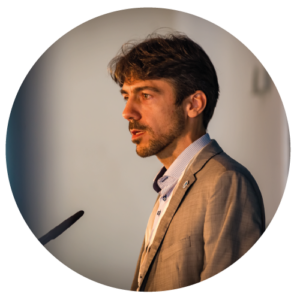State of the EU 2023 from a Protected Areas perspective
The “2023 State of the European Union: ANSWERING THE CALL OF HISTORY”, Ursula von der Leyen’s speech analysed from a Protected Areas perspective.
On 13 September, in front of the Members of the European Parliament (MEPs) in Strasbourg, the President of the Commission Ursula von der Leyen presented the annual speech about the State of Union. This year it was especially important because the last one before the end of this Commission’s mandate. As we know, in June 2024 the European citizens will vote for the elections for the new European Parliament, and then a new Commission and a new President will be appointed.
Here EUROPARC underlines the aspects that refer to Protected Areas, analysing what Mrs von der Leyen said, and also what was missing in her speech, in order to offer more knowledge, and food for thought, about the Brussels’s current political debates directly connected to our work.
The speech, pronounced by Ursula von der Leyen, touched several points, among which the Ukraine war, digitalisation and artificial intelligence, immigration, economy, NextGenerationEU, future EU enlargement to the Balkans countries, and others.
The European Green Deal was of course one of the key themes.
Without any doubts, EUROPARC considers the launch of the Green Deal is the most important achievement of the current European Commission, and strongly appreciates that the President of the Commission stated: “We now have a European Green Deal as the centrepiece of our economy and unmatched in ambition”.
Presenting the results achieved and future actions about climate change and green transition, Mrs von der Leyen focused essentially on the industry sector, speaking about the EU’s support and related package of measures for energy transitions, competitiveness against not-European markets, job market and growth strategy, clean steel factories, investment in clean hydrogen.
Of course, without a strong acceptance of the green ambitions by the industrial sector, the Green Deal cannot reach its goals. But, speaking about industrial policies, Mrs von der Leyen says that “this is the strength of Europe’s response to climate change”. Inside of this crucial part of the discourse, EUROPARC, instead, would have much appreciated a strong declaration that climate change is not only a matter of industry but also strongly a matter of management of territories and landscapes focusing on protection and sustainable use of biodiversity and nature. The results of the two United Nations Conferences in 2022, on Climate Change (COP27) and on Biodiversity (COP15), clearly put in evidence.
Nevertheless, some of these considerations are mentioned later in the following part of the talk about nature protection that Mrs von der Leyen addressed to MEPs. Together with the cultural diversity, that makes the ”Europe of the Regions”, the President reminds us that Europe is a continent of unique biological diversity. She mentioned the Wadden Sea and the Baltic Sea, as well as the European Plain of moorland and wetland, as important allies against climate change and to secure regional water cycles, and unique for biodiversity. In EUROPARC’s eyes, this list of examples seems very limited but at least they refer to important ongoing discussions. For example, the Baltic Sea remains the most polluted sea in Europe and the European Commission is organising a high-level conference with the presence of the Commissioner for Environment, Oceans and Fisheries Virginijus Sinkevičius (“Our Baltic Conference” in Palanga, Lithuania, on 29 September 2023).
Then, Mrs von der Leyen spoke about woodland: coniferous forests of the North and East forests, cork oak forests of southern Europe, and last remnants of virgin oak and beech forest in central Europe are “irreplaceable source of goods and services”.
EUROPARC could not agree more when Mrs von der Leyen concluded:
Biodiversity and ecosystem services are vital for all of us in Europe. Loss of nature destroys not only the foundations of our life, but also our feeling of what constitutes home. We must protect it.
Immediately after, the speech continues about food security and farming. “At the same time, food security, in harmony with nature, remains an essential task”. It is clear that this part of the discourse aims to reinsure farmers that their work is appreciated and that the Commission takes into account their concerns. Indeed the speech touches at this point on one of the most sensitive topics, especially in the recent and current debates about the nature restoration law and about large carnivores: the relation between agriculture and nature conservation. About this theme, Mrs von der Leyen underlined that: “For us in Europe, this task of agriculture – producing healthy food – is the foundation of our agricultural policy. And self-sufficiency in food is also important for us.” Reminding all about the consequences of Ukraine war, droughts, fires, and flooding, as well new obligations for farmers, the President admonishes that they “are all having a growing impact on farmers’ work and incomes. We must bear that in mind.”
Only after this premise, the speech mentions the efforts done by a part of the farming sector towards a more sustainable form of agriculture. About that: “We must work together with the men and women in farming to tackle these new challenges. That is the only way to secure the supply of food for the future.” Then, with a clear reference to the last hot debates inside the European Parliament and outside between farming and environmental sectors, Mrs von der Leyen made a strong invitation: “We need more dialogue and less polarisation”, and a proposal for the next future: “That is why we want to launch a strategic dialogue on the future of agriculture in the EU.” “Dialogue” is the crucial word that EUROPARC uses about the need to reinforce partnership between farmers and Protected Areas, so we are very willing to know more about how this proposal will be implemented.
The President concluded this part of the speech with a statement that EUROPARC shares totally: “I am and remain convinced that agriculture and protection of the natural world can go hand in hand. We need both.”
What was missing in this speech?
According to EUROPARC, some very crucial topics. For instance: the Restoration Law. Probably it is too sensitive at this moment because the Commission, Parliament and Council are working in the “trialogue” to conclude the process. However, definitely, we regret the total lack of references to the importance of the law, and in general to the Biodiversity Strategy. The same for all other important Strategies (soil, forests) approved during this Commission’s mandate and ignored in the speech. Speaking about agriculture: no mention on pesticides, or other crucial and complex themes; and no mention of the large carnivores (about that the President launched recently a personal initiative about wolf that is considered quite divisive). Other big absent: marine (only rapidly mentioned with the two examples of nature diversity) and ocean conservation, and dialogue with fishermen (probably assimilated with farmers). Moreover, as said above, not enough strong message that nature protection should be a key part of Europe’s response to climate change. And last but not least for us, no mention of the role of Protected Areas and Natura2000 as key actors and key allies for the Green Deal.
EUROPARC has always been supportive of the European Commission in its efforts for the European Green Deal (see letter here) and we are ready and willing to continue in the future as it benefits our members (see webpage here). The European elections in 2024 will be crucial for the future of the Green Deal. We strongly hope that the new Parliament and the new Commission will continue, improve and reinforce the commitments towards more sustainability, more nature protection, and also more recognition of the role of key actors, such as the Protected Areas, to reach these objectives. That will be necessary if we really want to ANSWER THE CALL OF HISTORY.
The text of the speech is available here in all languages, and here in the original version.
The records of the speech, and the following interesting debate with the interventions of Members of the European Parliament from all political groups, are available here.
Measuring the Environmental Impact of EcoTourism: Learnings and Tools for a Greener Future
Sustainable Tourism is an ever relevant topic for EUROPARC and Protected Areas. Accurately assessing environment impacts is essential if we want truly sustainable tourism. In this article, discover tools developed by the MEET Network that support this process.
Today is World Tourism Day. It is a good day to celebrate that Protected Areas are among the most visited places in Europe.
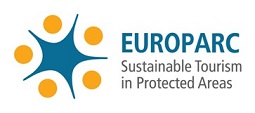 The European Charter for Sustainable Tourism (ECST) in Protected Areas is one of EUROPARC main programmes that helps Protected Areas to plan and manage tourism sustainably.
The European Charter for Sustainable Tourism (ECST) in Protected Areas is one of EUROPARC main programmes that helps Protected Areas to plan and manage tourism sustainably.
It has three phases. Phase 1 is addressed to Protected Areas. Phase 2 is addressed to Tourism Business and Phase 3 to Travel Agencies and Tour Operators.
Measuring environmental impact is essential to understand and address any potential damage to the environment. It is one of the key topics that Protected Areas need to work on to obtain their ECST award.
However, accurately measuring environmental impacts and ecological footprint is not easy. The MEET Network provides a new tool to measure environmental impact of ecotourism that could be very useful for ECST Protected Areas, Business and Travel Agencies.
This tool has been already tested in two ECST Parks: Garrotxa Natural Park and Colline Metallifere National Park
Keep on reading to learn more. Plus, mark your calendars for our next webinar on this topic: 2 November 10:00 CET.
This article is written by Arnau Teixidor Costa, Ecosystem Resilience & Spatial Planning Programme and Lucía Prieto Fustes Ecosystem Programme Assistant. Arnau and Lucía both work at IUCN Centre for Mediterranean Cooperation
Measuring the Environmental Impact of EcoTourism: Learnings and Tools for a Greener Future
Ecotourism holds the promise of delivering positive benefits to the conservation of protected areas and local communities by supporting the sustainable development of destinations. However, measuring and evidencing these benefits is challenging. As a result, the different impacts of (eco)tourism are not consistently measured. To address this, the MEET Network and the DestiMED PLUS project partnership have developed a comprehensive approach. This includes a standard, indicators and tools, to assess the enabling conditions for ecotourism to be developed in the protected area destination, and the sustainability and quality of the ecotourism itineraries.
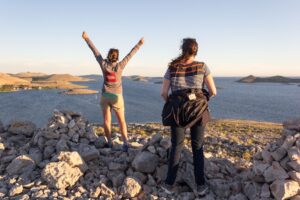
Ecotourists hiking in Kornati National Park © MEET Network (Author: Vicki Brown)
The MEET Network gathers tourism and environmental organizations along protected areas to transform the Mediterranean into a leading ecotourism destination.
MEET was born out of several Euro-Mediterranean initiatives, such as ENI CBC MED Programme MEET project, and its Secretariat is based at the International Union for the Conservation of Nature (IUCN) Centre for Mediterranean Cooperation. Its primary mission is to craft top-tier ecotourism experiences that benefit both environmental conservation and local communities. In the recent DestiMED PLUS project, MEET has perfected its model and its tools for measuring ecotourism impacts.
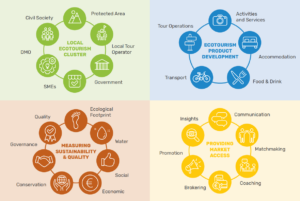
The 4-step MEET Model. The bottom-left step indicates the approach to measuring the impact of the tourism experiences © MEET Network. Click to enlarge
The MEET model is based on a 4-step process (see the image to the right) which ensures that the itinerary created complies with the promise of ecotourism.
Understanding the impact on Earth’s resources
In the context of global change, a main feature of the MEET approach for measuring impact is understanding the environmental footprint of ecotourism itineraries. This builds on work by the Global Footprint Network in developing a robust methodology for measuring the ecological footprint of ecotourism itineraries, tested by measuring 13 ecotourism itineraries across the Mediterranean. The DestiMED PLUS project allowed not just to refine the understanding of the ecological footprint of 9 new ecotourism itineraries, but also to compare it with the footprint of travel to the destination and the average footprint of travellers and residents. Additionally, it allowed to explore the carbon and water footprints in some destinations, while exploring the capacity of the different environmental foot print methodologies to measure the impact of the tourism sector.
Over the past years, we have been developing, through the MEET Network and its various projects, a participatory process based on data and monitoring processes to develop a sustainable alternative for tourism activities in and around Mediterranean protected areas, which work for the benefit of both people/communities and the planet. Looking forward to the possibility of bringing this approach to other protected areas in the region.
Says Alessandro Galli, President of the MEET Network.
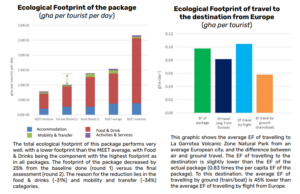
Ecological footprint results in La Garrotxa Volcanic Zone Natural Park © MEET Network. Click to enlarge.
The assessment of the ecological footprint has allowed to draw interesting lessons for ecotourism operators, destination and protected area managers:
- Food & Drinks represented the major footprint driver in all itineraries analysed, contributing on average to 63% of the total.
- On average, the Ecological Footprint of a tourist travelling from Europe to a norther-Mediterranean ecotourism destination is 43% higher than the per capita Ecological Footprint of the average entire stay at destination.
- It is challenging to establish an ideal or maximum ecological footprint per ecotourist per day, as this needs to be assessed along social, cultural and economic impacts in the destination, as well as origin, length of stay, means of travel, etc.
What MEET measuring and monitoring tools can you use?
For protected and conserved area managers to be able to assess and manage different impacts and ensure the enabling conditions for ecotourism to flourish under the MEET Standard, a set of tools has been developed and compiled in an online ecotourism indicator monitoring platform. The platform offers a summary assessment of the environmental and social results for each destination and itinerary, allowing managers to make informed decisions. It also proposes resources and guidelines to streamline the required data collection and analysis. The platform comprises four main tools:
- The Ecological Footprint Calculator: As seen above, it measures tourism services in a package/itinerary across four key categories: accommodation, food & drinks, mobility, and activities & services. It assists tourism stakeholders in analyzing the environmental impact of ecotourism experiences within protected areas. Users gather data through surveys conducted in collaboration with local service providers. The tool harmonizes this data with existing statistics to yield a quantitative ecological footprint and generic recommendations to enhance the sustainability of ecotourism.
- The Social Impact Assessment of Ecotourism Suppliers tool quantifies the social impact generated by diverse ecotourism service providers, suppliers, and facilities included in an itinerary. More importantly, it examines the perspectives of four key stakeholder groups: workers, local communities, value chains, and visitors. This assessment can be understood as an evaluation of the different socio-economic dimensions linked to the ecotourism product and offers a deeper understanding of its social implications.
- In contrast to the preceding tools, which examine the social and environmental impacts of tourism products, the Enabling Conditions Assessment of the Destination introduces a set of criteria that destinations are encouraged to embrace to establish the necessary foundations for sustainable tourism practices. They aim to safeguard natural resources, bolster local communities, and advocate for responsible ecotourism development. The tool is based on IUCN’s Best Practice Guidelines for the Governance of Protected Areas to establish an evaluation framework, incorporating a simplified version of the IUCN Green List Global Standard for Protected Areas.
- In a similar fashion, the Product Quality Assessment of an Ecotourism Itinerary tool delves into crucial aspects related to product and itinerary design, safety protocols, supplier selection, and more. This assessment is conducted through a survey process that harnesses existing data already available to the Inbound Tour Operator.
Looking ahead
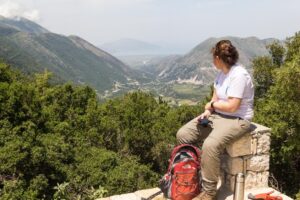
Ecotourist in Vlorë, Albania © MEET Network (Author: Vicki Brown)
There are many challenges and opportunities for ecotourism to deliver its promise as it navigates the delicate balance between economic development and environmental conservation. In a context of overvisitation in many protected and conserved areas, supporting a tourism officer that is delivering positive impacts is needed. For this, a comprehensive approach for measuring the impacts of ecotourism is essential, championing ecotourism as an important piece upon which the tourism sector changes in the face of the climate and biodiversity crisis and the call for regenerative and responsible tourism. And this message cannot stay in the Protected Areas, it needs to reach destination managers and marketers , industry and travellers.
Interested in learning more? Have a look at the MEET website and manual!
50th Anniversary: Quo Vadis, the EUROPARC?
EUROPARC is turning 50. On this occasion, our president turns directly to our membership with a message on the past, present and future.
Article issued by our President, Michael Hošek, for the EUROPARC members.
A message from our President Michael Hošek to EUROPARC members for our 50th Anniversary
The 50th EUROPARC Federation General Assembly will be held on 3rd October 2023. Not every organisation can overcome such a long period of time, and not every organisation can maintain a high and stable membership. It is a cause for celebration, but also for reflection on where we have come since 1973, and what path we want to take next.
From our perspective, those who founded the Federation in 1973 lived in a simpler environment. However, this is only true on the surface. They also lived in a Europe divided in two by the Iron Curtain. This was also the case in Germany itself, at that time two different countries. Perhaps that is why EUROPARC was founded in the West Germany. And the communication and cooperation between the states in those two different “Europes” was not very intense either.
In the field of nature conservation, the administrators of Protected Areas (hereinafter PAs) were by far the most aware of this, which is why they founded the Federation. Not only today, but even at that time, PAs were one of the most successful tools in our field, but we often reinvented practices that had long been proven elsewhere, or were unable to effectively protect wildlife occurring on the borders of several countries. So from the beginning, EUROPARC’s goal was a combination of simple communication to share experiences and active cooperation on this basis.
The ‘boom’ in terms of development came in the 1990s, after the Velvet Revolution and the lifting of the Iron Curtain. Suddenly, the number of partners and potential members in Europe “doubled”, and EUROPARC, with its existence and objectives, hit the need of the time: to have a common platform for a cooperation. And further development has come in this millennium, with new technological and project opportunities, where the Federation has grown and continues to grow in terms of developing and applying tools not only for its members, but also as a team with growing professional expertise. Just have a look at our website, because today it is no longer within the power of an individual to actively participate as a member in all Federation activities.
Today, with approximately 400 members in 40 countries, we are by far the largest international membership organisation in Europe, and probably globally in terms of our focus on protected areas. But more importantly, we have a clear vision, set by our 2030 Strategy – the one we adopted as members in 2021 – with the vision of “Sustainable nature; valued by People”. As well as, the mission “To improve and champion the policy and practice of Protected Areas to ensure that our natural and cultural heritage is protected and enhanced for current and future generations”. But the world is changing rapidly, and we need to be able to interpret our objectives in the light of this. Fast enough, but most importantly, appropriately enough, so that we do not lose sight of our mission. To this end, allow me the following reflection.
Protected Areas strengthen at strategic level
When we were negotiating the Global Biodiversity Framework (GBF) for 2030, achieving 30% coverage of Protected Areas was one of the main goals that the document managed to push through. And we have the same in the EU Biodiversity Strategy 2030. The EU countries are now developing plans to expand their networks. But the important thing is that the importance of Protected Areas is now recognised by perhaps everyone – not only as a tool for biodiversity conservation, but also for climate change adaptation and mitigation, and not least as a model for sustainable use of the landscape. And we should not lose that momentum.
Protected Areas and beyond their borders
However, it is also clear that, particularly in Europe, the current model cannot be used without further changes. In addition to the need to work with local communities to manage Protected Areas, other tools must be found to bridge the gap between Protected Areas and the “unprotected landscape”. The new concept of “Other effective area-based conservation measures” (OECMs), or “areas separate from Protected Areas”, where conservation is achieved mainly as a by-product of other management, should serve this purpose. In other words, not as a primary conservation activity, but as activity of other sectors (mainly agriculture, forestry, fishery,…) as economic activity. OECMs, if applied, can be a suitable intermediate step that contributes to a mix of land uses, but in a sustainable way, without being a protected area. And it is up to us as the EUROPARC to actively participate in the further development of this concept. Most of the EU countries want to use it as a tool to achieve the 30×30 target, i.e. to “designate” OECMs as an enlarged part of Protected Areas networks. That is an opportunity, but also a threat to weaken Protected Areas, and we should be well aware of it.
Innovative financing is not just about money
EUROPARC is already very active in the search for new funding models for Protected Areas. This varies widely from country to country. In some of them the sources for ensuring care are suitably diversified, in others it is still mainly the state budget. But with Innovative financing comes not only “new money” but also new partnerships – with business, with the research community, with the general public, who are also increasingly ready to support us directly. But above all, it is a process in which new tools of care are developed with partners. These are now often focused on adaptation or mitigation of climate change (e.g. through carbon offsetting schemes), further opening up space for a broader perception of the role of Protected Areas.
Let’s focus on what is important and leave out the unimportant
There is a plethora of opportunities for projects and activities. It is now easy to communicate and create not only valuable outputs, but also the appearance of them. And EUROPARC must therefore consider which activities are meaningful and beneficial to its members, and which (although also important) are not a priority at the time compared to our resources. This is always a difficult decision, made all the more difficult at a time of many new concepts and ideas. But I believe that it can be done, and our involvement in selected activities, including active promotion of new topics, is proof of that.
But in any case, permanent feedback from you, our members, is necessary. And on the Council, again, not only to respond to change, but also to ensure a stable strategic direction that is not subject to quick fads for no good reason.
50th-anniversary special | Presidents of EUROPARC: Moments that shaped the Federation
With a grand celebration like a 50th birthday comes a wonderful opportunity to gather significant people who have influenced and shaped us. It’s a chance to showcase how far we have come by celebrating our accomplishments and successes.
It’s a time of reflection and gratitude.
So who better to talk to than EUROPARC Presidents?
Already interested in hearing the reflections of Dr Patrizia Rossi, Michael Starrett, Erika Stanciu, Thomas Hansson, Ignace Schops, and Michael Hošek?
Then enjoy our special podcast, which includes insights about the key moments that have led EUROPARC to where it is today.
Celebrating our 50th anniversary at the EUROPARC Conference
Taking place during EUROPARC’s Golden Anniversary year, the Conference provides a place for the EUROPARC network to reflect on 50 years of Connecting People and Parks, and look to the future. We feel incredibly honoured to have the opportunity to bring together all the exceptional people who have devoted their lives to nature protection.
Let’s celebrate together! We look forward to meeting you in Leeuwarden, the Netherlands, from 3 to 6 October.
You can listen to other EUROPARC Podcast episodes here. Enjoy!
